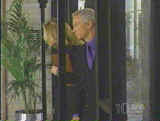
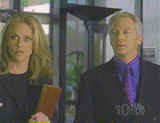
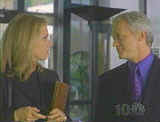
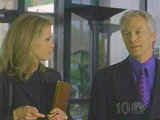
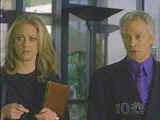
PROFILER
The Root of All Evil
PROFILER, "The Root of All Evil," two-hour long, second season finale. First
airdate May 9, 1998. The dramatic series follows a criminal "profiler," an
expert at interpreting evidence at a crime scene for insights into the perpetrator. James
Morrison plays Will Cook, a photojournalism editor haunted by the faces of disaster.
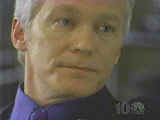 A chain of explosions rocks the parking lot at an Atlanta chemical company during
a shift change. Twenty-three people die as vehicles around them explode. Once the fire
settles, the FBI's Violent Crime Task Force, including profiler Dr. Samantha Waters and
her boss Bailey Malone arrive on the scene. The chemical company could have many enemies,
they speculate, because it manufactures controversial pharmaceuticals. With the help of a
company security tape, they determine the cars rigged to blow were the ones without locked
gas caps, which indicates the bombs had been randomly set. Forensics discovers thermite, a
simple-to-make explosive, is the substance that blew up the cars.
A chain of explosions rocks the parking lot at an Atlanta chemical company during
a shift change. Twenty-three people die as vehicles around them explode. Once the fire
settles, the FBI's Violent Crime Task Force, including profiler Dr. Samantha Waters and
her boss Bailey Malone arrive on the scene. The chemical company could have many enemies,
they speculate, because it manufactures controversial pharmaceuticals. With the help of a
company security tape, they determine the cars rigged to blow were the ones without locked
gas caps, which indicates the bombs had been randomly set. Forensics discovers thermite, a
simple-to-make explosive, is the substance that blew up the cars.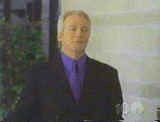
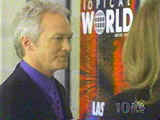 Sam goes to Will
Cook's offices at "World Magazine." She mentions the series of photos on
Davison's mantel. "I put them there," Cook said. "I also took them."
He tells her he used the camera James had dropped in the grass. When Sam compliments him
upon his photographic skill, he demurs, "I'm strictly point-and-shoot. Even an
amateur pulls out of the sand trap every once in a while."
Sam goes to Will
Cook's offices at "World Magazine." She mentions the series of photos on
Davison's mantel. "I put them there," Cook said. "I also took them."
He tells her he used the camera James had dropped in the grass. When Sam compliments him
upon his photographic skill, he demurs, "I'm strictly point-and-shoot. Even an
amateur pulls out of the sand trap every once in a while."
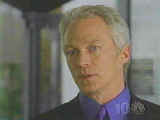
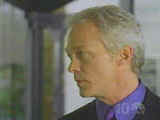 Although Cook is
aware of Davison's crimes, his affection for his longtime friend and co-worker is obvious.
"There was a time when I hero-worshipped him," he tells Sam. "I considered
it an honor to edit his books." He has known Davison since he was "a camera nut
wandering Greenwich Village" photographing faces, especially the eyes. The eyes in a
Davison shot, he mentions, eventually became "his trademark."
Although Cook is
aware of Davison's crimes, his affection for his longtime friend and co-worker is obvious.
"There was a time when I hero-worshipped him," he tells Sam. "I considered
it an honor to edit his books." He has known Davison since he was "a camera nut
wandering Greenwich Village" photographing faces, especially the eyes. The eyes in a
Davison shot, he mentions, eventually became "his trademark."
"James Davison could capture a decade in a single portrait," Cook tells Sam. As
she glances around the magazine's office, seeing all the famous photographs, she is
inclined to agree. She asks what happened to him.
The subject matter eventually got to Davison and has not left Cook
unscathed, either. "Bodies broken into pieces," he explains. "Blood so
thick it covers the top of your shoes. How many times can you look at the face of a
starving kid, snap a picture, then go back to your regular life?"
Sam steers the conversation back to the series of photos from the church fire. Was that
the first time Davison put down his camera? Cook calls it "the last straw" and
mentions it was the last time they worked together. Since then, Cook adds, Davison has
disappeared.
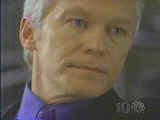 Sam, who has seen plenty of pain on the job and at home, muses about how hard it
must be to be objective when surrounded by that much pain. Cook tells her he and Davison
talked many times about that. "I think James was looking for reasons." Wondering
about Davison's motivations, Sam asks if he thought Davison had been looking for blame.
"He felt we were all to blame. In a way, he's right." Cook lists several
international trouble spots. "We pay lip service, read the stories, look at the
pictures. But what do we really do about it?"
Sam, who has seen plenty of pain on the job and at home, muses about how hard it
must be to be objective when surrounded by that much pain. Cook tells her he and Davison
talked many times about that. "I think James was looking for reasons." Wondering
about Davison's motivations, Sam asks if he thought Davison had been looking for blame.
"He felt we were all to blame. In a way, he's right." Cook lists several
international trouble spots. "We pay lip service, read the stories, look at the
pictures. But what do we really do about it?"
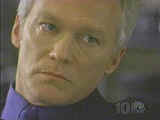
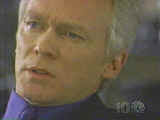 Knowing Davison is
gearing up for a big finale, Sam asks his old friend what he thinks he will do. Cook sits
a moment and then says, "Something - that will create an image the world will never
forget." Davison had wondered what it would be like to reveal a disaster before it
happened and prevent it. "Something instead of just chronicling the aftermath."
Sam asks him to make a list of stories Davison covered, as well as a list of stories he
wanted to cover.
Knowing Davison is
gearing up for a big finale, Sam asks his old friend what he thinks he will do. Cook sits
a moment and then says, "Something - that will create an image the world will never
forget." Davison had wondered what it would be like to reveal a disaster before it
happened and prevent it. "Something instead of just chronicling the aftermath."
Sam asks him to make a list of stories Davison covered, as well as a list of stories he
wanted to cover.
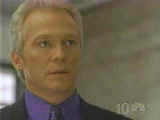
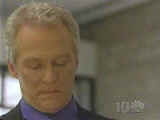 After coolly
discussing his troubled friend with a stranger, Cook stops Sam on her way out the door.
Cook tells her, "Do you know what you'd find if you looked inside his head 20 years
ago, Dr. Waters? Somebody full of midnight courage. Somebody you could call a hero.
Someone you would like -- " his control slips a moment as he chokes " - an awful
lot."
After coolly
discussing his troubled friend with a stranger, Cook stops Sam on her way out the door.
Cook tells her, "Do you know what you'd find if you looked inside his head 20 years
ago, Dr. Waters? Somebody full of midnight courage. Somebody you could call a hero.
Someone you would like -- " his control slips a moment as he chokes " - an awful
lot."
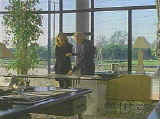
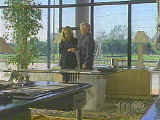 Later, Cook comes up
with the lists Sam requested. They meet in his office to go over the photos. Mention of
Davison's obsession with "the root of all evil" prompts Cook to say, "I
know he felt he made a living off the misery of the world. It bothered him. I told him we
have a responsibility to let the world know." Studying the photographs of suffering
faces, Sam wonders if Davison ever published anything that didn't emphasize faces.
"He's into people," Cook replies. Then he speculates on Davison's final victim:
"He's basically a moral guy. He'll probably take retribution on himself."
Later, Cook comes up
with the lists Sam requested. They meet in his office to go over the photos. Mention of
Davison's obsession with "the root of all evil" prompts Cook to say, "I
know he felt he made a living off the misery of the world. It bothered him. I told him we
have a responsibility to let the world know." Studying the photographs of suffering
faces, Sam wonders if Davison ever published anything that didn't emphasize faces.
"He's into people," Cook replies. Then he speculates on Davison's final victim:
"He's basically a moral guy. He'll probably take retribution on himself."
Meanwhile, Davison may be missing, but his mission continues. Bailey and
Sam receive a report of another confession in Washington, DC. Davison had allowed the
survivor to live once he mentioned NASA putting plutonium in rockets. The man with a
second chance is an engineer who advised NASA to shoot plutonium off into space in the
first place.
In her home darkroom, Sam loads the negatives agents confiscated from Davison's apartment
into her own enlarger to study the images. Davison may have been known for photographing
close-ups of people, but Sam finds photos of things and places, such as the bus he had
bombed in Chicago and the chemical plant he had targeted in Atlanta. In addition to his
past targets, she finds an oddly abstract image - a pattern of lines crossing and
intersecting, like a grid of pipes. She wonders if that photo is an indication of his next
target.
She shows the prints she has made from Davison's negatives to Bailey. Deep inside the
intricate gridwork, he spots the letters "ANE." He believes that to be part of
the word "methane," which is highly explosive with or without the addition of a
thermite bomb. Since Davison's current obsession seems to be the NASA project, they wonder
how methane could fit into the picture. Bailey realizes Houston, Texas, has a network of
natural gas pipelines running under the city. Houston is also the site of NASA's mission
control center. Since, according to Davison's previous pattern, they have less than 24
hours to find and stop him, Sam and Bailey fly off to Houston.
At the gas company's main plant, Sam advises the manager they should find a place both
central and vulnerable. The manager counters by pointing out the massive sprawl of pipes
and conduits, then adds, "If that maniac sets off his thermite anywhere around here,
we're ghosts."
As they try to determine his next step, somewhere under the gridwork of gas pipes is
Davison carrying his rolled up mat of thermite and a long sparkler.
And Sam knows he's there, citing his pattern of no more than 24 hours between confession
and retribution. With her mind racing, she suggests he "thinks in pictures," so
he has a perfectly composed image already in mind as his precise target. She suggests
George, who is working on the computer back at the task force's headquarters, run a
comparison program between the gas company's plans and the specific composition of a
parallel lines of pipe making a frame.
George finds places that match that specific pattern, and gas company workers scramble to
shut off service to the junctions. While Sam and Bailey race to stop him, Davison makes
his confession alone. Only, this time, the confessor is not saved. The sparkler burns down
to the mat, the thermite explodes and he disappears into a ball of flame. The pipes
overhead remain unscathed. All Sam and Bailey find left of the troubled photojournalist is
ash.